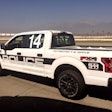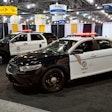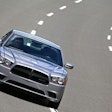With gasoline prices hovering at the $3.60 mark nationwide, the Ford Motor Co. is touting its 2012 Police Interceptor as a patrol car that offers significant fleet fuel savings over the company's earlier model.
Without releasing specific mpg ratings for the 2012 police interceptors, the company has announced its pair of next-gen patrol vehicles would offer a 20% improvement on fuel usage over the Crown Vic. Ford has dominated the law enforcement market in recent years with its CVPI, which they rate at 14/21 mpg city/highway, according to the company.
The Detroit auto manufacturers don't release specific fuel-efficiency ratings for law enforcement vehicles. They do, however, release mpg ratings for the retail vehicles on which they are based. These are usually derived from controlled research and test driving under optimal conditions.
Operational, or real-world, fuel efficiency for police vehicles relates more to the mission, individual driver, and road conditions. As one example, a highway patrol agency would operate longer on a fuel tank than a municipal agency.
Ford is releasing its Interceptor sedan and utility SUV with a 3.5-liter V6 base model available in front-wheel or all-wheel drive and an AWD 3.5-liter EcoBoost V6 model.
The retail versions of the vehicles — Ford Taurus SHO EcoBoost turbo and Ford Explorer — are rated at 19/25 mpg.
The 2011 Dodge Charger Pursuit's mpg should also be in line with the retail Charger, which is offered in a 3.6-liter V6 at 18/27 mpg and a 5.7-liter V8 at 16/25 mpg, a company spokesman tells POLICE Magazine.
General Motors is initially offering its police-only 2011 Chevy Caprice PPV in a 6.0-liter V8 model. In 2012, agencies can purchase a 3.6-liter V6 powertrain. The V8 model is rated at 15/24 mpg, according to Dana Hammer, GM's law enforcement manager.
It should be noted that patrol vehicles typically operate at lower fuel efficiency than their retail counterparts because cruiser engines often idle during traffic enforcement work or officer investigations.
Also, Ford is releasing a different powertrain on its base-model Interceptor than the one offered on its Ford Taurus on which it is based. The powertain on the retail Taurus is rated at 263 hp, while the police version produces 280 hp, company spokeswoman Marisa Bradley tells POLICE Magazine.
To achieve its increased fuel savings, Ford has paired multi-valve dual overhead cam engineering with computer controlled twin independent variable cam shaft timing (Ti-VCT) for its base model. The feature allows the engine to respond to the driver's need for performance or for torque, according to commands from the car's computer.
In recent weeks, Ford spoke with three law enforcement agencies with fleets of CVPIs — the Los Angeles County Sheriff's Department, Detroit Police Department, and Berkley (Mich.) Police Department — to determine how much the agencies would save in fuel costs.
The following information was provided by the company as results from that survey:
The Los Angeles County Sheriff's Department operates a fleet of 6,200 vehicles that patrol an area the size of Connecticut. In 2010, those vehicles drove more than 27 million miles. A fleet-wide 20-percent fuel economy gain would save the department at least $20 million a year at today's fuel prices of nearly $4 per gallon, according to Ford.
The city of Detroit spent roughly $10 million on gasoline for its police fleet in 2010. Switching to the new Ford Interceptor sedan and utility would save the Detroit Police Department about $2 million annually.
The smaller town of Berkley, just north of Detroit, maintains a police fleet of 13 Crown Victoria cars to patrol the city's 2.2 square miles. Berkley had been spending about $2,500 per month on gasoline for its cars before the recent surge in fuel prices. A 20-percent fuel economy gain for Berkley's patrol cars would have equaled a savings of $500 per month or $6,000 per year.
Editor's Note: If your agency now provides Ford CVPIs to officers, what kind of operational fuel mileage are you seeing with the vehicles? Please add your comment below or e-mail POLICE Magazine at editor@policemag.com.
Related:




















